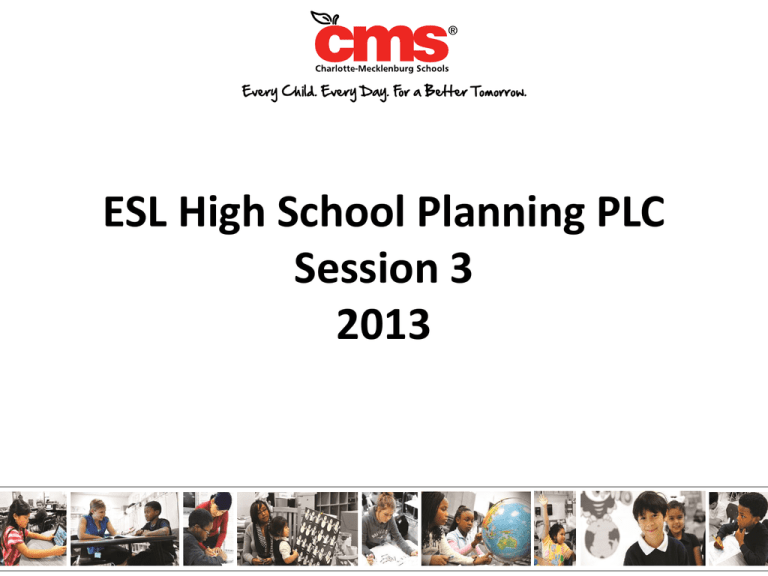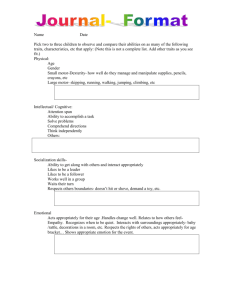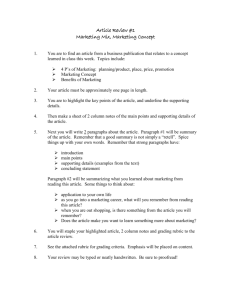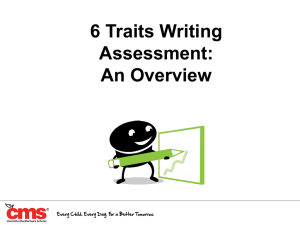ESL High School Planning PLC Session 3
advertisement

ESL High School Planning PLC Session 3 2013 Good Morning • Sign in at the table by the door. • Enjoy a snack. • Make a name tag. • Put the text: Fish Cheeks in order. 2 Text Reformation As a group decide on at least one sentence to move to change the order of the text. Discuss the implications of the changes at your table. Share your changes with the group. 3 After-Reading Strategies: Scales A subjective, low-stress way to examine and discuss a text. 4 After-Reading Strategies: Scales • Likert Scales -- similar to those seen on surveys Amy was rude at the New Year’s dinner: Strongly disagree disagree agree strongly agree The important thing is discussing why the student agrees/disagrees, not just the rating itself. 5 After-Reading Strategies: Scales • Semantic Differential Scales – placing a character or event on a continuum between opposite descriptors. Amy was… Proud of her family ---------------------------- Embarrassed by her family. Again, the important thing is discussing why the student chose the position on the continuum. 6 After-Reading Strategies: Retelling Somebody Wanted But So -- a template for retelling a narrative. Somebody Wanted… But… Princess Leia … get her … Darth Vader stolen plans captured her of the Death ship Star to the Rebel Alliance So… … she hid the plans in an R2 droid and sent him to the planet Tatooine in an escape pod 7 After-Reading Strategies: Retelling Now complete the template for “Fish Cheeks”: Somebody Wanted… But… So… Amy Tan 8 Bloom’s Taxonomy, Revised Formulating Questions Question Types Which type has more rigor? Passive questions: response mode, answered by student Active questions: questions asked by the student 9 ELLs NEED MORE RIGOR ! Use Bloom’s Revised to help! Remember Understand Apply Analyze Evaluate Create 10 Model different kinds of questions that stimulate HOTS. Low Level Thinking Skills Think about “Little Red Riding Hood” Low Level Thinking/Questions How many little girls are in the story? What happened first in the story? Did Little Red know where she was going? 11 Now think “higher”… High Level Thinking Would you rather be the wolf or Little Red? Why? What other stories are similar to Little Red? Explain… What other endings to the story might be possible? Describe… 12 Strategy: Think-Write-Share • Work with a partner. • Think about Fish Cheeks. • Write a “low level” list of questions on top of page. • Then…change them into HOT questions! 13 Stragegy:“Give & Take Journal” Questioning & writing communication: Topic: Fish Cheeks Partner 1: Write a HOT question for partner to answer in writing. Partner 2: Answer partner’s question; then formulate a question for them to answer. Continue until complete Share verbally what you wrote and why with partner. 14 Fractured Fairy Tales • Strategy: Add more rigor in thinking, comprehension, and writing. • Think about Fish Cheeks. • How could you extend the story, change the location, turn it into a fairy tale or another genre of story, change the setting, add more characters, instill humor, give it a twist, use modern day language…..all without changing the main premise of the original???? 15 Work in your small group… • Discuss how you will “fracture the story”. • Brainstorm the possibilities. • You must include the selected vocabulary words from the story . • Chart the story …….and then decide how you will share out with total class. Think HOTS ! 16 Jigsaw: Writing Strategies •Read your assigned strategy. •Explain your strategy to the group creatively. Scaffold Argument Analysis Chart pages: 149-150 Take a Stand p. 151 Sequencing Flow Chart p. 160 Paragraph Frames and Essay pages: 163-165 Fact Cards p. 158 17 How to Teach Students to Provide a Written Response with Organization and Development 1. Sentence Frames with or without word-level support Example: Question: What lesson did Tan learn over time? Answer: Over time, Tan learned _____________________. 18 How to Teach Students to Provide a Written Response with Organization and Development Why did Tan’s mother serve her daughter’s favorite foods? Tan’s mother served her daughter’s favorite foods because she wanted to please her. What foods did Tan’s mother serve on Christmas Eve? Tan’s mother served rock cod, tofu, fungus, and squid on Christmas Eve. How did Tan feel during dinner that night? Tan felt embarrassed during dinner that night. 19 How to Teach Students to Provide a Written Response with Organization and Development 2. Paragraph Frames with or without word-level support Example: Question: Based on the text, how does the author describe Bobby in the text? According to the text, the author describes Bobby in __________ ways. First, in paragraph 4, the author says __________________. Next, in paragraph 7, the author used the words ______________ to describe Bobby. Finally, in paragraph 9, the author says _____________. Based on the text, I think Bobby is _list of character traits to refer to . 20 Color Coded Paragraph Frames Topic Sentence Supporting Details plus transition Elaboration Supporting Details plus transition Elaboration Supporting Details plus transition Conclusion 21 Color Coded Paragraph Frames Why was the author embarrassed during dinner? The author was embarrassed during dinner several times. The first time she was embarrassed was when her relatives licked the ends of their chopsticks and reached across the table. They put their chopsticks into the plates of food. Secondly, she was embarrassed when her father poked his chopstick into the eye of the fish. She said she wanted to disappear after he said, “Amy, your favorite.” The final straw to her embarrassment, was when her father belched at the table. Even though he explained the custom, she was “stunned into silence”. The author was embarrassed many times during dinner because her culture was different from that of her guest. 22 6 Traits Writing Assessment: an Overview What is “6 Traits”? • A model for teaching and assessing • Developed when researchers asked the question, “What are the traits of good writing?” How Can 6 Traits Help LEPs? • Language proficiency issues generate even more issues in developing good writing • LEPs bring many different skill-levels to the process • 6 Traits is flexible and standards-based, allowing you to evaluate each student against his or her own progress Rubric Assessment • Holistic approach • Address each trait separately Introducing: The Traits 1. 2. 3. 4. 5. 6. Ideas Organization Voice Word Choice Sentence Fluency Conventions Ideas The content of the piece. -- p. 35 Ideas • • • • Select an idea Narrow the idea Elaborate on the idea Discover the best information to convey the idea Ideas • • • • Select an idea (the topic) Narrow the idea (focus) Elaborate on the idea (development) Discover the best information to convey the idea (details) Ideas Rubric 2 – Emerging 3 – Developing 4 – Expanding 5 – Bridging Thesis, main idea or main theme is emerging. Details are present. Thesis, main idea or main theme is apparent. Details are present, although not always necessarily relevant or appropriate. Content area concepts are reflected, but perhaps not at grade-level level of comprehension. Thesis, main idea or main theme is clear. Details are accurate and relevant. Details at least tangentially support the thesis, theme or main idea. Content material approaches being appropriate to grade-level and intended audience. Ideas are strong and original. Thesis or main theme is clear and compelling. Details are accurate, relevant and wellchosen. Details clearly support the thesis, theme or main idea. Content material is appropriate to grade-level and to intended audience. 31 Organization Organization is the internal structure of the piece, the thread of central meaning, the pattern of logic. -- p. 70 Organization • An inviting introduction gets the reader started and gives clues about what is to come. • Thoughtful transitions link key points and ideas. • Sequencing should be logical, purposeful, and effective. • Pacing – speeding up for wide angle and slowing down for close-ups – should be under control. • A satisfying conclusion wraps it all up, yet leaves the reader with something to wonder about. Organization • An inviting introduction gets the reader started and gives clues about what is to come. • Thoughtful transitions link key points and ideas. • Sequencing should be logical, purposeful, and effective. • Pacing – speeding up for wide angle and slowing down for close-ups – should be under control. • A satisfying conclusion wraps it all up, yet leaves the reader with something to wonder about. -- p. 71 Organization Rubric 2 – Emerging 3 – Developing 4 – Expanding 5 – Bridging An organizational structure to the writing is starting to emerge with either a beginning, an end, or perhaps both present. An obvious organizational structure is present, although may be simplistic or “cookie-cutter”, and not strictly ideal for the content. Transitions may be minimal or lacking. An obvious organizational structure is present; a beginning, middle, and an end are present and all connected with logical transitions. The structure bears an appropriate relationship to the content. A creative, strong flow to the writing results from an internal organization that draws the reader in and then moves him/her through the piece from beginning to end. 35 Voice Voice is the golden thread that runs through a piece of writing. It’s how the reader knows it is really you. -- p. 102 Voice • • • • Where the writer reveals their personality Very difficult to teach Use quality writing for examples Seems to be best achieved through honesty Voice At minimum, writing should evidence an awareness of: • Audience • Context • Significance of the topic • Attempting to connect the audience to the writing Voice Rubric 2 – Emerging 3 – Developing 4 – Expanding 5 – Bridging Struggles with word choice and sentence fluency limit most displays of voice, both as a representation of the student’s personality, and as an attempt to address the audience in an appropriate register. The student attempts to engage the audience and address the purpose, but fails to make a perceivable connection. Writing may be somewhat lifeless, mechanical. The response shows an awareness of the purpose and audience for this prompt. The student reveals their personality or engagement to the topic to some degree. Response is engaging and appropriate to purpose and audience. The writer reveals a style that clearly reflects his or her personality. 39 Word Choice … the use of rich, colorful, precise language that communicates not just in a functional way, but also in a way that moves and enlightens the reader. -- p. 142 Word Choice • • • • Precision Clarity Variety “grade-level appropriateness” Word Choice • An area of weakness for our students • Strong vocabulary is developed through reading • That vocabulary can be wonderfully reinforced through its application in writing Word Choice Rubric 2 – Emerging 3 – Developing 4 – Expanding 5 – Bridging English words relate to prompt. Word choice is weak and at times inaccurate. A heavy dependence on high-frequency words and phrases limits expression. English words address prompt. Word choice is simplistic and basic. Attempts are made to employ contentspecific vocabulary, with varying degrees of success. English words respond to prompt. Word choice includes synonyms and words that are more complex. Technical and content-based vocabulary emerges and is used with some accuracy. A varied vocabulary is employed to express concepts clearly and vividly. Technical and content-based vocabulary is used appropriately and with confidence. 43 Sentence Fluency Fluent writing is graceful, varied, rhythmic – almost musical. It’s easy to read aloud. -- p. 178 Sentence Fluency Is best described by what to avoid: • Repetitive sentence structures • Short, choppy sentences • Incorrect sentence structures Sentence Fluency • LEPs need to work on this trait • Overtly teach varied sentence structures • On rewrites, challenge students to use the same words in new ways Sentence Fluency Rubric 2 – Emerging 3 – Developing 4 – Expanding 5 – Bridging Two or more complete sentences are present, but there are problems with grammar or a repetitive sentence pattern. Two or more complete sentences are present and are grammatically correct. There is variation in the sentence structures. Two or more complete and correct sentences are present, there is variation in structure and that variation enhances the flow and readability of the piece. A variety of sentence structures are employed in a manner that enhances the material and the flow and readability of the piece. Complex syntax structures are handled deftly and used appropriately. 47 Conventions Almost anything a copy editor deals with comes under the heading of conventions: punctuation, grammar and usage, capitalization, and paragraphing. -- p. 214 Conventions • Spelling • Grammar • Punctuation Conventions Rubric 2 – Emerging 3 – Developing 4 – Expanding 5 – Bridging Some words are capitalized, spelled or punctuated correctly; most are not. Capitalization & punctuation are mostly correct. Spelling is usually right. Grammar & usage are still very weak. Capitalization, punctuation, spelling, and grammar usage are strong and usually correct. Little editing would be required to make this piece perfect. Appropriate conventional structures, such as letter greetings or bulleted lists, are attempted and recognizable. Capitalization, punctuation, spelling, and grammar usage are correct. Appropriate conventional structures, such as letter greetings or bulleted lists, are employed in the correct format or style. 50 Activity • In your folder is a page with three columns, with “6 Traits of Writing” heading the left column and “Common Core Writing Anchor Standards” heading the right column. • Read each anchor standard and decide to which trait (or traits) it best corresponds. Draw a line to that trait. 51 Presenting… the Super Rubric • The packet printed in color in your folder is a “super rubric,” combining WIDA writing standards, 6 Traits, and the Common Core anchor standards. • You can check your work on the matching activity by seeing how the Common Core and 6 Traits are correlated here. 52 Planning Time Please complete the survey and evaluation before you begin planning. Thank you for participating in the PLC. Enjoy your holiday!!! 53





